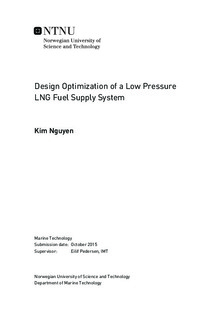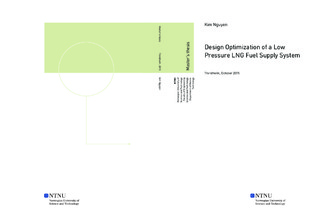| dc.description.abstract | In 2014 there were 50 liquefied natural gas (LNG) fuelled ships in operation and around 70 on order worldwide. LNG proves to emit less pollution and considering the present and future emission regulations and optimistic gas fuel prices, LNG would be a preferable option as a marine fuel. The number of LNG fuelled ships is therefore likely to increase significantly the next five to ten years.
There are many ways to configure the fuel supply system. The fuel supply system consists of a tank, heat exchangers and a gas valve unit (GVU) that are connected by pipes and valves. The focus area of this study was the low-pressure (LP) LNG fuel supply system. Three different LP LNG fuel supply systems was studied and optimized in this thesis:
CASE 1: Supply system with two shell-and tube exchangers.
CASE 2: Supply system with one shell-and-tube exchanger.
CASE 3: Supply system with one compact exchanger and one shell-and-tube exchanger.
The modeling, simulations and optimization for these three cases were done in the commercial simulation tool Aspen HYSYS and the additional HYSYS-software, Exchanger Design & Rating (EDR). The simulations showed how dependent the process parameters were on the other system parameters. Further, a sensitivity analysis performed gave an understanding of how the mechanical parameters of the heat exchanger affect the overall design including thermal and hydraulic parameters such as heat transfer rate and pressure drop.
For the optimization of the process parameters for the heat exchangers the inlet temperature difference of the two fluids, and type and mass flow of the heating medium was showed in this thesis to be vital. Mechanical parameters such as shell ID, tube OD and tube length were found to be vital parameters that affected not only the mechanical design but the thermal and hydraulic parameters as well.
This study only focused on the heat exchangers in the regasification system, and factors such as the pressure loss in pipes and the pressure loss through valves and fittings are not included. To get an overall understanding of the complete fuel system including tank, pressure build-up (PBU) unit, piping system and other devices concerning regasification, heating or re-liquefaction, a further study can be conducted with a system including these components. | |

